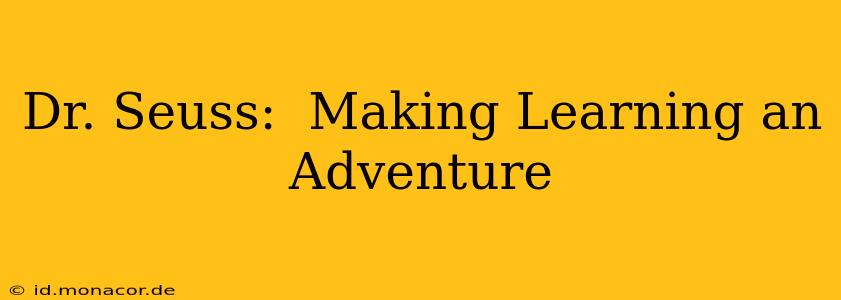Dr. Seuss, the pen name of Theodor Seuss Geisel, transcends the label of "children's author." He was a master storyteller, a whimsical wordsmith, and a pioneer in making education fun and accessible. His enduring legacy rests not just on catchy rhymes and fantastical creatures, but on his profound understanding of how to engage young minds and foster a lifelong love of learning. This exploration delves into the magic behind Dr. Seuss's success, examining his techniques and lasting impact on literacy and education.
What makes Dr. Seuss's books so effective for teaching children?
Dr. Seuss's genius lay in his ability to seamlessly blend entertainment with education. His books aren't just stories; they're carefully crafted learning experiences. He masterfully employed several techniques:
-
Catchy Rhymes and Rhythms: The rhythmic nature of his prose makes his books incredibly engaging, making reading aloud a joyful experience for both children and adults. This rhythmic quality improves phonemic awareness, a crucial skill in early literacy development.
-
Repetitive Phrases and Simple Vocabulary: Repetitive phrases and a controlled vocabulary allow young children to predict words and build confidence in their reading abilities. This repetition reinforces vocabulary and helps children internalize language patterns.
-
Vibrant Illustrations and Visual Storytelling: His illustrations are as captivating as his words, adding another layer of engagement. They help children understand the story even before they can fully decipher the text. The visual cues assist in comprehension and memory retention.
-
Addressing Important Themes: While entertaining, his stories tackle complex issues like environmentalism ("The Lorax"), prejudice ("The Sneetches"), and the importance of self-acceptance ("Horton Hears a Who!"). These themes expose children to important concepts in an age-appropriate and accessible manner.
How did Dr. Seuss influence children's literacy?
Dr. Seuss's impact on children's literacy is undeniable. His books have:
-
Increased Reading Engagement: His unique style makes reading fun, encouraging children to pick up books and enjoy the process. This increased engagement fosters a love of reading that can last a lifetime.
-
Improved Vocabulary and Language Skills: His carefully chosen vocabulary and rhythmic text help children expand their vocabulary and develop strong language skills.
-
Boosted Confidence in Reading: The repetitive phrases and predictable patterns in his books help children build confidence in their reading abilities. This confidence is crucial for continued literacy development.
-
Inspired Generations of Authors and Illustrators: His innovative approach to children's literature has inspired countless authors and illustrators, shaping the landscape of children's books for decades to come.
What are some of Dr. Seuss's most popular books and their educational value?
Many Dr. Seuss books stand out for their educational value:
-
The Cat in the Hat: A classic introduction to reading, featuring simple vocabulary and repetitive phrases. It demonstrates the joy of reading and the power of imagination.
-
Green Eggs and Ham: This book uses repetition and simple sentences to reinforce basic vocabulary and reading skills. It's a great example of how engaging storytelling can boost reading comprehension.
-
Fox in Socks: This tongue twister focuses on phonics and pronunciation, making it an ideal tool for improving speech and reading fluency.
-
One Fish Two Fish Red Fish Blue Fish: This book introduces basic concepts like counting and colors in a playful and memorable way.
Are there any criticisms of Dr. Seuss's work?
While widely celebrated, some of Dr. Seuss's earlier works have faced criticism for containing stereotypical and insensitive portrayals of certain groups. It's important to acknowledge these criticisms and engage in thoughtful discussions about representation and inclusivity in children's literature. Many publishers have taken steps to address these issues by revising or removing problematic content from some editions.
How can parents and educators use Dr. Seuss's books effectively in teaching?
Dr. Seuss's books provide a rich resource for parents and educators. They can be used for:
-
Shared Reading: Reading aloud together fosters a love of reading and strengthens the parent-child bond.
-
Phonics Instruction: The rhythmic text and repetitive phrases are great for teaching phonics and phonemic awareness.
-
Vocabulary Building: The books introduce new vocabulary in a fun and engaging way.
-
Storytelling and Creative Writing: The imaginative stories inspire creativity and encourage children to develop their own storytelling skills.
-
Discussions about Important Themes: The books provide opportunities to discuss important social and emotional issues with children.
Dr. Seuss's legacy continues to inspire and educate generations. His unique approach to children's literature has not only made reading fun but has also profoundly impacted literacy development worldwide. By understanding his techniques and thoughtfully integrating his books into teaching strategies, we can continue to harness the power of his storytelling to foster a love of learning in young minds.

